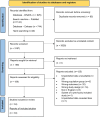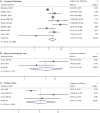Endotracheal Tube-Associated Complications in Paediatric Critical Care: A Systematic Review and Meta-Analysis
- PMID: 40522230
- PMCID: PMC12169073
- DOI: 10.1111/nicc.70066
Endotracheal Tube-Associated Complications in Paediatric Critical Care: A Systematic Review and Meta-Analysis
Abstract
Background: Children admitted to the paediatric intensive care unit who require mechanical ventilation are at increased risk for endotracheal tube complications. Increased endotracheal tubes complications can lead to increased length of stay and subsequent increased health care costs.
Aim: To estimate the incidence of endotracheal tube-associated infections and other complications in mechanically ventilated children.
Study design: Systematic review and meta-analysis of observational studies. The electronic databases and search machines PubMed, Embase and Cumulative Index of Nursing and Allied Health Literature (CINAHL) were searched for articles published 2012 to 2023. We included cohort studies and randomized controlled trials set in paediatric intensive care that reported endotracheal tube-associated complications (infection, accidental removal, pressure injuries and blockage). Study eligibility assessment, data extraction and critical appraisal were undertaken by pairs of reviewers. Pooled estimates of complications were generated using random effects meta-analysis. Study quality was assessed using the Critical Appraisal Skills Programme tool for randomized controlled trials and cohort studies.
Results: We included data from 34 studies (12 RCTs and 22 cohort studies; n = 50 359 patients; 232 123 ventilator days). There was substantial study heterogeneity. The primary outcome was endotracheal tube-associated infection: ventilator-associated pneumonia, ventilator-associated events and/or ventilator-associated tracheobronchitis. Ventilator-associated pneumonia was the most common endotracheal tube-associated complication (incidence rate 13.5/1000 ventilator days; 95% confidence interval [CI] 8.2, 22.2) with higher rates in low- and middle-income countries than high-income economies (incidence rate difference 11.9%; 95% CI 10.2, 13.7). Accidental extubation was the second most common complication (7.4/1000 ventilator days; 95% CI 5.1, 10.7) followed by endotracheal tube-associated pressure injuries (5.4/1000 ventilator days; 95% CI 1.7, 16.6) and endotracheal tube blockage (5.0/1000 ventilator days; 95% CI 1.4, 17.6).
Conclusions: Endotracheal tube-associated complications remain prevalent and contribute avoidable harm. The continued high incidence of ventilator-associated pneumonia highlights further efforts are needed to reduce burden, especially in lower- and middle- income countries.
Relevance to clinical practice: Awareness of endotracheal tube-associated complications will promote initiatives to reduce complications and prevent patient harm. Prospero Registration: PROSPERO 2022 CRD42022339900.
Keywords: endotracheal tube; infection; intensive care unit; paediatric.
© 2025 The Author(s). Nursing in Critical Care published by John Wiley & Sons Ltd on behalf of British Association of Critical Care Nurses.
Conflict of interest statement
The authors declare no conflicts of interest.
Figures



References
-
- ANZICS Centre for Outcome and Resource Evaluation , “Australian and New Zealand Paediatric Intensive Care Registry Activity Report 2018,” (2018).
-
- Chen E., Airway Mucus Rheological Properties and Pulmonary Health (University of California, 2011).
Publication types
MeSH terms
LinkOut - more resources
Full Text Sources
Medical

